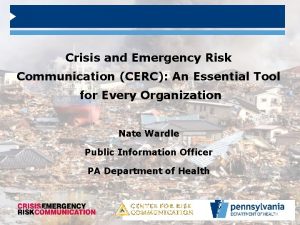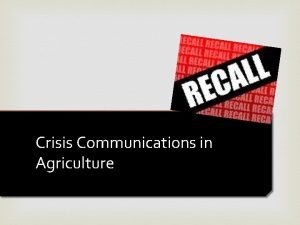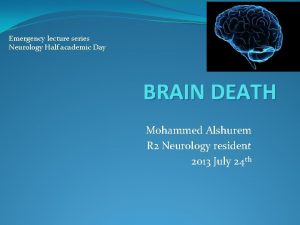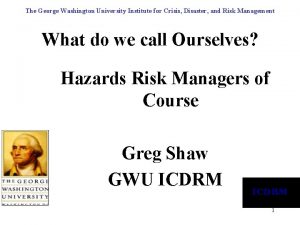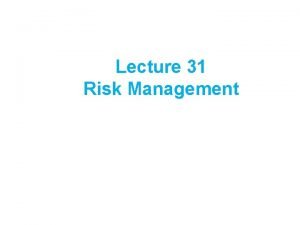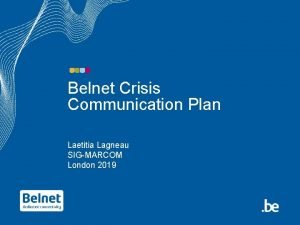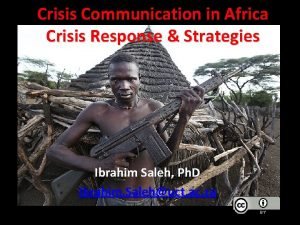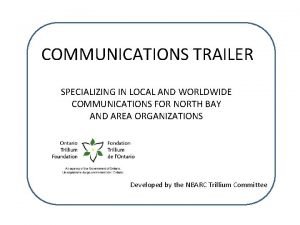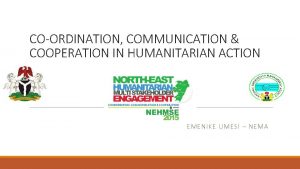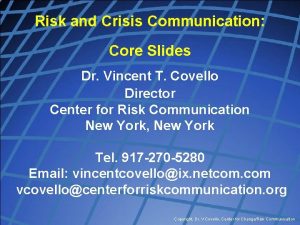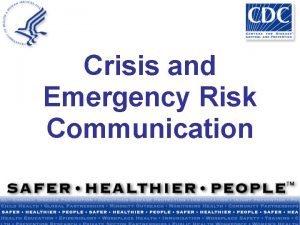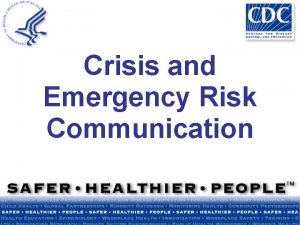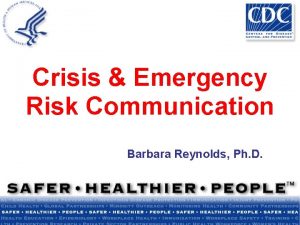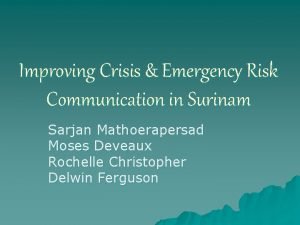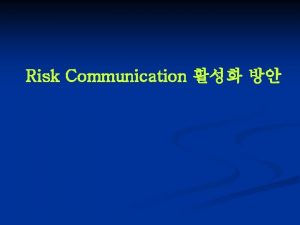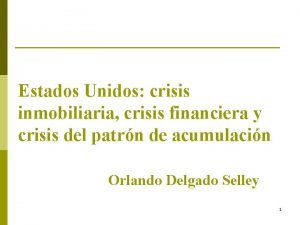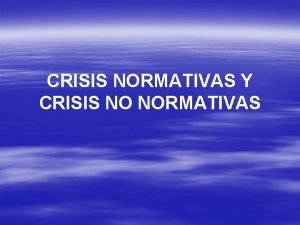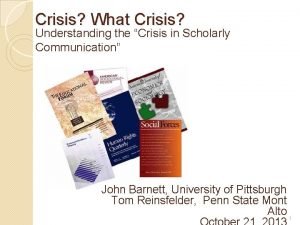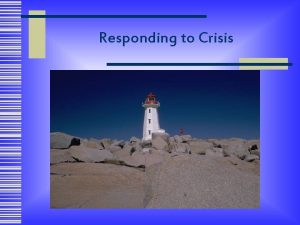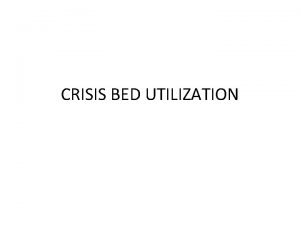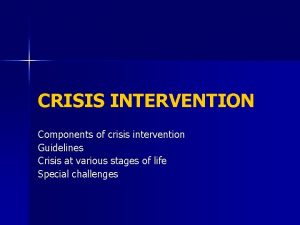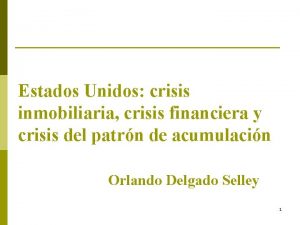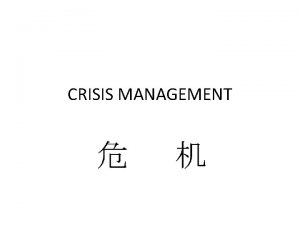Lecture 07 Crisis and Emergency Risk Communication 1
































- Slides: 32

Lecture 07 Crisis and Emergency Risk Communication 1

Risk Communication v/s Emergency Communication • During emergencies public health responders must effectively ensure the following types of communication – Institutional • Intra-inter-agencies/institutions, across levels • Inter-sectorial – Operational • To health care workers and respondents (e. g. alerts, guidance documents • To ensure the coordination of the response – To the public (risk communication) 2

Health crisis are unique • Extremely time pressuring • Unpredictable & unfolding • Socially and economically disruptive • Behaviour–centred & anxiety generator • Involving multiple stakeholders • Shifting from national to international 3

Communicating during crisis is a capacity requirement under the IHR Under the IHR, risk communication includes a range of interventions through preparedness, response and recovery of a health crisis for • informed decisions • positive behaviour interventions • maintenance of trust to minimize its public health impact. 4

Risk assessment Risk perception Risk communication Risk management 5

Do we have a shared understanding of ‘risk communication’? Risk Communication – Outbreak Communication – Crisis Communication – Emergency Communication Information – Education - Communication – Public Awareness – Public Education – Social Mobilization – Community Mobilization – Advocacy – Information Officer – Media Officer – Communication Officer – Reporting Officer – Advocacy Officer - Development Support Communication – Pandemic Communication – Animal Health Communication – Human Health Communication – Media Relations – Donor Relations – Corporate Relations – External Relations – Public Relations - Risk Communication – Outbreak Communication – Crisis Communication – Emergency Communication - Behaviour Change Communication – Development Communication – Participatory Communication – Programme Communication – Information – Education Communication – Public Awareness – Public Education – Social Mobilization – Community Mobilization – Advocacy – Information Officer – Media Officer – Communication Officer – Reporting Officer – Advocacy Officer - Development Support Communication – Pandemic Communication – Animal Health Communication – Human Health Communication – Media Relations – Donor Relations – Corporate Relations – External Relations – Public Relations - Risk Communication – Outbreak Communication – Behaviour Change Communication – Development Communication – Participatory Communication – Programme Communication – Information – Education - Risk Communication – Outbreak Communication – Crisis Communication – Emergency Communication - Behaviour Change Communication – Development Communication – Participatory Communication – Programme Communication – Information – Education - Communication – Public Awareness – Public Education – Social Mobilization – Community Mobilization - Risk Communication – Outbreak Communication – Crisis Communication – Emergency Communication - Behaviour Change Communication 6

7

8

Event management cycle Risk assessment Crisis communication Co nt ro lm n ea tio su ua al re s Ev WHO believes that it is high time to acknowledge crisis communication as essential to outbreak control as epidemiological training and laboratory analysis. Event detection 9

WHO crisis communication guidance started in 2004 • Expert consultation on Outbreak Communication (2004) • WHO evidence-based communication guidance (2004) • Outbreak Communication Planning Guide (2008) • Communication for behavioural impact (COMBI) (2012) Literature & field experience 10

« The overriding goal for outbreak communication is to communicate with the public in ways that build, maintain or restore Trust » 11

Trust is the public perception of Your motives Are the risk managers acting to safeguard my health? Your honesty Your skills Are the risk managers holding back information? Are the risk managers skilled enough to do the job? 12

Trust is the pillar of outbreak control « …the less people trust those who are supposed to protect them, the more afraid the public will be and less likely they will be to conform their choices and behavior with outbreak management instructions » . 13

re al Trust rs ch nic communicators and technical responders. Te • ato communicators and policy makers; nic • u mm Trust is essential between Co sp on de r s Building trust is also an internal process Policy makers The internal trust relationship is the “Trust Triangle” 14

Crisis Communication - Core Capacity Components 2. Public communication coordination 1. Transparency and early announcement of a real or potential risk PLANNING 4. Listening through dialogue 3. Information dissemination including media relations 15

1. Transparency and Early announcement of a real or potential risk • Those at real or potential risk can protect themselves; • Trust between authorities populations and partners is maintained and strengthened. 16

2. Public communication coordination • Existing public communication resources are used; • Messages are coordinated and confusion and overlap are reduced; • Reach and influence of provided advice are strengthened. 17

3. Information dissemination including Media relations Rapid and effective dissemination of information is crucial during health crisis and mass media are the pillar of it. Not only media! • • Health care workers; Local and religious leaders; Citizens’ representatives; SMS Social media; Internet; Toll-free telephone numbers; Door-to-door visits 18

4. Listening through dialogue • Community perceptions of risks are understood; • Adaptations to messages, materials and strategies are made; • Effectiveness of communication efforts is ensured to support sound decision making. 19

If crisis are difficult to predict, an outbreak communication strategy can be planned 1. Assessment 2. Coordination 3. Transparency People respond to what outberak controllers do, not just to what they say. 4. Listening 5. Communication evaluation 6. Emergency communication plan 7. Training Crisis communication must be integrated in risk management form the start. 20

Crisis Communication - Lifecycle • • • Pre. Crisis • • Explain about risks Inform Establish credibility Guide action Commit to communication Maintenance Initial Prepare Make alliances Agree on recommendations Test messages • • • Educate for future response • Individual action • Support for relevant policies • Promote agency activities Resolution Foster understanding of risks Provide background Foster support for plans Listen Empower Evaluation • Evaluate plan • Lessons learned • Identify improvement

Communication planning allows decision making 1. What is the situation? Evaluate the situation in context and time 2. Why communicate? Set objectives 3. To whom? Define target audience(s) 4. How? Outline strategy, channels and tools 5. When? Draw a timeline of action 6. Who? Identify roles and partners 7. With what? List human and economic resources 8. How is it going on? Monitor communication impact 9. How effective? Adjust the communication strategy 22

Gaps and challenges (from experience and feedback) • General devaluation of communication, not seen as a science; • Disconnect between technical and communication responders; • Low recognition of crisis communication capacity needs before a crisis starts; • Perception of crisis communication as an “add-on” not integrated in planning processes; • Limited financial and human resources dedicated to communication planning; • Unsuitability of planned procedures due to other sectors’ involvement and/or lead taken by the highest government’s level. 23

Crisis communication is designed for health crisis • Extremely time pressuring Information dissemination • Unpredictable & unfolding Dealing with uncertainty • Socially and economically disruptive Coordination - Listening • Behaviour–centred & anxiety generator Listening • Involving multiple stakeholders • Shifting from national to international Coordination 24

Crisis Communication Resources • WHO Outbreak Communication Guidelines (2005) www. who. int/infectious-disease-news/IDdocs/whocds 200528 en. pdf • WHO Outbreak Communication Planning Guide (2008) www. who. int/ihr/elibrary/WHOOutbreak. Comms. Planng. Guide. pdf • WHO Communication for behavioural Impact (2012) http: //www. who. int/ihr/publications/combi_toolkit_fieldwkbk_outbreaks/en/ • CDC Crisis and Emergency Risk Communication Manual http: //emergency. cdc. gov/CERC/ • PAHO Risk and Outbreak Communication http: //new. paho. org/hq/index. php? option=com_content&view=article&id=1940&Itemid=19 23&lang=en

Crisis Communication - Lifecycle • • • Pre. Crisis • • Explain about risks Inform Establish credibility Guide action Commit to communication Maintenance Initial Prepare Make alliances Agree on recommendations Test messages • • • Educate for future response • Individual action • Support for relevant policies • Promote agency activities Resolution Foster understanding of risks Provide background Foster support for plans Listen Empower Evaluation • Evaluate plan • Lessons learned • Identify improvement

What the public seeks from your communication 5 public concerns. . . 1. Gain wanted facts 2. Empower decision making 3. Involved as a participant, not spectator 4. Provide watch guard over resource allocation 5. Recover or preserve well-being and normalcy 27

Crisis and Emergency Risk Communication impacts 5 organizational concerns -- you need to. . . 1. Execute response and recovery efforts 2. Decrease illness, injury, and deaths 3. Avoid misallocation of limited resources 4. Reduce rumors surrounding recovery 5. Avoid wasting resources 28

5 communication failures that kill operational success 1. 2. 3. 4. Mixed messages from multiple experts Information released late Paternalistic attitudes Not countering rumors and myths in realtime 5. Public power struggles and confusion 29

5 communication steps that boost operational success 1. 2. 3. 4. 5. Execute a solid communication plan Be the first source for information Express empathy early Show competence and expertise Remain honest and open 30

Summary • Risk Communication v/s Emergency Communication • Communicating during crisis is a capacity requirement under the IHR • Crisis Communication - Core Capacity Components • 5 communication failures that kill operational success 31

Thank You 32
 Crisis and emergency risk communication
Crisis and emergency risk communication Crisis communications lecture
Crisis communications lecture Market risk credit risk operational risk
Market risk credit risk operational risk Myasthenic crisis vs cholinergic crisis ppt
Myasthenic crisis vs cholinergic crisis ppt Dolls eyes exam
Dolls eyes exam 01:640:244 lecture notes - lecture 15: plat, idah, farad
01:640:244 lecture notes - lecture 15: plat, idah, farad Institute for crisis disaster and risk management
Institute for crisis disaster and risk management Ladder up risk assessment
Ladder up risk assessment Risk management lecture
Risk management lecture Crisis communication working group
Crisis communication working group Crisis communication plan
Crisis communication plan Crisis communication skills
Crisis communication skills Public response
Public response Residual risk and secondary risk pmp
Residual risk and secondary risk pmp Business risk vs financial risk capital structure
Business risk vs financial risk capital structure Relative risk and attributable risk
Relative risk and attributable risk Population attributable risk
Population attributable risk Ham radio communications trailers
Ham radio communications trailers Communication coordination cooperation during the emergency
Communication coordination cooperation during the emergency Business communication lecture slides
Business communication lecture slides Risk projection
Risk projection Risk reduction vs risk avoidance
Risk reduction vs risk avoidance Absolute risk vs relative risk
Absolute risk vs relative risk Tracing vs vouching
Tracing vs vouching Absolute risk vs relative risk
Absolute risk vs relative risk Activity sheet 3: stock market calculations answer key
Activity sheet 3: stock market calculations answer key Risk classification system
Risk classification system Risk financing adalah
Risk financing adalah The biggest risk is not taking any risks
The biggest risk is not taking any risks Key risk indicators template
Key risk indicators template Ir x cr x dr
Ir x cr x dr Risk map
Risk map Dr vincent covello
Dr vincent covello
